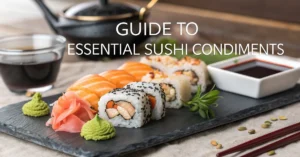Have you ever wondered what makes that sushi roll so distinctly… seaweed-y? Or why some nori sheets are crisp and flavorful while others are, well, less so? It all boils down to the nori seaweed itself – the unsung hero of countless Japanese dishes. Choosing the right nori can elevate your homemade sushi from good to amazing.
This guide isn’t just about buying any nori. It’s about understanding what makes one sheet superior to another. We’ll dive deep into the world of nori, exploring its different grades, flavors, and textures. By the end, you’ll be equipped with the knowledge to confidently select the best nori for your culinary creations.
What is Nori Seaweed?
Nori is a dried seaweed product used extensively in Japanese cuisine. It’s made from red algae of the genus Pyropia, traditionally cultivated in shallow coastal waters. Today, much of the production comes from controlled aquaculture environments.
The process of making nori involves:
- Harvesting: The seaweed is harvested, typically in winter and early spring.
- Washing: It’s thoroughly washed to remove any impurities.
- Chopping: The seaweed is then finely chopped.
- Sheet Forming: The chopped seaweed is mixed with fresh water in order to make a slurry, then spread thinly onto screens or mats, much like making paper, where it is then pressed and shaped into thin sheets.
- Drying: These sheets are dried, often in the sun or using specialized drying equipment, resulting in the familiar paper-thin, dark green nori sheets.
- Toasting: Some nori is toasted before packaging. This process can impart a crisper texture and enhance flavor.
Nori is known for its distinctive flavor, which is a blend of:
- Umami: A savory, mouthwatering quality.
- Slightly Salty: A hint of the ocean.
- Subtle Sweetness: A gentle undertone.
Why Does Nori Quality Matter?
Think of nori as the foundation of your sushi. A weak foundation compromises the entire structure. Here’s why choosing high-quality nori is paramount:
- Taste: Superior nori delivers a richer, more nuanced flavor that complements the other ingredients in your sushi. Inferior nori can taste bland, papery, or even slightly fishy.
- Texture: High-quality nori should be crisp and slightly brittle, snapping cleanly when you bite into it. Lower grades may be chewy, tough, or easily tear.
- Aroma: Good nori has a pleasant, sea-air fragrance. Avoid packages with a strong, off-putting smell.
- Durability: Sturdy nori is essential for rolling sushi. It needs to be strong enough to hold the ingredients together without tearing or becoming soggy.
- Nutrition: While all nori provides nutritional benefits (more on that later), higher-quality nori often retains more of its natural nutrients due to careful processing.
Nori Grades: Understanding the Spectrum
Nori grading can be complex, but knowing the basics will significantly improve your selection process. Nori is primarily graded based on color, texture, and overall appearance.
Color
The color of nori is a key indicator of its quality.
- Ideal: Deep, dark green with a slight sheen. This indicates high chlorophyll content and proper drying.
- Acceptable: Green with slight brown or red tinges. This can indicate slight over-processing or less-than-ideal storage conditions.
- Avoid: Pale green, yellow, or heavily discolored. These suggest significant quality issues.
Texture
The texture of nori should be crisp and even, not rough or uneven.
- Ideal: Smooth, slightly glossy surface with a uniform thickness. The sheet should snap easily when bent.
- Acceptable: Mostly smooth with minor imperfections. Some flexibility is acceptable, but avoid sheets that feel overly pliable.
- Avoid: Rough, brittle, or easily torn. These indicate poor quality and difficulty in handling.
Appearance
Overall appearance refers to the sheet’s integrity, cleanliness, and lack of defects.
- Ideal: Intact sheets, free from holes, debris, or blemishes. The edges should be clean and straight.
- Acceptable: Minor imperfections, such as small tears or occasional discoloration. These shouldn’t affect the nori’s functionality.
- Avoid: Extensive damage, significant contamination, or uneven edges.
While there is no single international standard for grading nori, certain terms and classifications are commonly used:
- Gold/A Grade: The highest quality, characterized by a deep green color, smooth texture, and minimal imperfections.
- Silver/B Grade: Good quality, with slight variations in color or texture compared to Gold grade.
- Red/C Grade: Acceptable quality, but with noticeable imperfections. Suitable for applications where appearance is less critical.
Keep in mind these classifications can vary between suppliers. Always rely on your own judgment and the factors outlined above.
Types of Nori: For Sushi and Beyond
While nori is synonymous with sushi, it’s a versatile ingredient with many applications.
Yaki Nori (Toasted Nori)
This is the most common type, readily available in supermarkets. Yaki means “toasted” in Japanese. Toasting enhances the nori’s flavor and crispness.
- Uses: Sushi rolls, onigiri (rice balls), as a garnish for ramen or other noodle dishes.
Ajitsuke Nori (Seasoned Nori)
This nori is flavored with soy sauce, sugar, mirin (sweet rice wine), and sometimes spices. It’s often cut into smaller sheets.
- Uses: As a snack, a side dish with rice, or a topping for bento boxes.
Mitsuba Nori (Three-Leaf Nori)
This is a higher-grade nori made from the first harvest of the season. It’s known for its tender texture and delicate flavor.
- Uses: Premium sushi, enjoyed on its own as a delicacy.
Kizami Nori (Shredded Nori)
Nori that has been cut into thin strips.
- Uses: Garnish for noodle dishes, soups, or rice bowls.
Aonori (Green Nori Flakes)
A different type of seaweed altogether, but often sold alongside nori. Aonori has a vibrant green color and a milder flavor.
- Uses: Sprinkle over takoyaki (octopus balls), okonomiyaki (savory pancake), or yakisoba (stir-fried noodles).
Factors Affecting Nori Quality
Several factors influence the quality of nori, from cultivation to processing.
Harvesting Season
The first harvest of the year, typically in winter, yields the highest-quality nori. This “first flush” nori is more tender and flavorful.
Cultivation Method
Nori can be cultivated in natural environments or controlled aquaculture systems. Sustainable aquaculture practices can produce high-quality nori while minimizing environmental impact.
Processing Techniques
The washing, chopping, drying, and toasting processes all affect the final product. Careful processing preserves the nori’s flavor, texture, and nutritional value.
Storage Conditions
Nori is highly susceptible to moisture. Proper storage in an airtight container, away from heat and light, is crucial to maintain its quality.
Reading the Label: What to Look For
Decoding the labels on nori packages can help you make informed choices.
Ingredients
The ingredient list should be short and simple: dried seaweed. Avoid products with artificial additives, colorings, or excessive preservatives. Seasoned nori will, of course, have additional ingredients like soy sauce, sugar, and spices.
Origin
Some regions are known for producing high-quality nori. Look for nori from Japan, Korea, or China. However, origin alone doesn’t guarantee quality.
Certifications
Look for certifications that indicate sustainable harvesting practices or organic production. Common certifications include:
- Aquaculture Stewardship Council (ASC): Promotes responsible aquaculture.
- Organic: Guarantees the nori was produced without synthetic pesticides or fertilizers.
Expiration Date
Check the expiration date to ensure freshness. Nori can lose its flavor and crispness over time.
Where to Buy Nori
Nori is widely available, but the quality can vary depending on the source.
- Asian Supermarkets: Offer the widest selection of nori, including various grades and types.
- Specialty Food Stores: May carry higher-end nori brands known for quality.
- Online Retailers: Provide convenience and access to a broad range of products, but be sure to read reviews and check the seller’s reputation.
- Mainstream Supermarkets: Generally offer basic yaki nori, suitable for everyday use.
Pro Tips for Choosing the Best Nori
Here are some insider tips to help you select the best nori:
- Look for a Deep Green Color: This is the most reliable indicator of quality.
- Check for a Snapping Sound: When you bend a sheet of nori, it should snap cleanly.
- Smell It: Good nori has a pleasant, sea-air fragrance.
- Avoid Packages with Visible Moisture: This indicates improper storage.
- Buy Smaller Quantities: Nori loses its crispness over time, so it’s better to buy smaller amounts more frequently.
- Read Reviews: See what other consumers have to say about different brands and products.
- Experiment: Try different types and grades of nori to find your personal preference.
Nori Nutrition: More Than Just Sushi
Nori isn’t just delicious; it’s also packed with nutrients:
- Iodine: Essential for thyroid function. Nori is a naturally rich source of iodine.
- Vitamins: Contains vitamins A, B, C, and E, which are important for overall health.
- Minerals: Rich in calcium, iron, magnesium, and potassium.
- Protein: Provides a modest amount of protein.
- Fiber: Contributes to digestive health.
- Antioxidants: Contains antioxidants that help protect against cell damage.
However, it’s important to consume nori in moderation due to its high iodine content. Excessive iodine intake can be harmful to some individuals.
Storing Nori Properly
Proper storage is essential to maintain nori’s quality.
- Airtight Container: Store nori in an airtight container to protect it from moisture.
- Cool, Dark Place: Keep the container in a cool, dark place away from direct sunlight.
- Desiccant Packets: Include desiccant packets to absorb any excess moisture.
- Avoid Refrigeration: Refrigeration can introduce moisture and make the nori soggy.
- Use Promptly: Once opened, use the nori within a few weeks for optimal freshness.
Common Nori Problems and Solutions
Even with careful selection, you might encounter some common nori problems.
- Sogginess: If nori becomes soggy, you can try toasting it lightly over a gas flame or in a dry pan to restore its crispness.
- Tearing: If nori tears easily, try using slightly damp hands when handling it. This will make it more pliable.
- Bland Flavor: If nori lacks flavor, try using seasoned nori or adding a light brush of soy sauce or sesame oil.
- Tough Texture: If nori is tough, try steaming it briefly before use. This will soften it slightly.
Beyond Sushi: Creative Uses for Nori
Nori’s versatility extends far beyond sushi.
- Snacks: Toast nori sheets lightly and sprinkle with sea salt for a healthy snack.
- Soups: Add shredded nori to miso soup or ramen for a boost of flavor and nutrients.
- Rice Bowls: Crumble nori over rice bowls with toppings like avocado, edamame, and a drizzle of soy sauce.
- Salads: Cut nori into strips and add it to salads for a salty, umami flavor.
- Seasoning: Grind nori into a powder and use it as a seasoning for vegetables, tofu, or fish.
- Popcorn: Toss popcorn with melted butter and nori flakes for a savory twist.
- Sandwiches: Add a layer of nori to sandwiches for extra flavor and texture.
Experiment and Enjoy
With this comprehensive guide, you’re now equipped to navigate the world of nori with confidence. Don’t be afraid to experiment with different grades, types, and uses to discover your personal preferences.
The next time you’re preparing sushi or any other dish calling for nori seaweed, remember the tips and insights shared here. By selecting high-quality nori and storing it properly, you’ll elevate your culinary creations and enjoy the full flavor and nutritional benefits this amazing ingredient has to offer.



